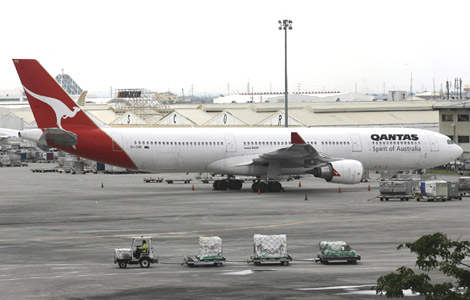Launch was key to China's space program
Updated: 2011-11-01 11:51
(Xinhua)
|
|||||||||||
JIUQUAN - Chinese Vice Premier Zhang Dejiang, who supervised the Shenzhou-8 blastoff on site, said here Tuesday morning the successful launch signals one key step closer to a victory of China's first space docking.
A modified Long March-2F rocket carried, starting from 5:58 am Tuesday at the Jiuquan Satellite Launch Center, the unmanned spacecraft into the orbit, which was live broadcast nationwide.
Shenzhou-8 is expected to dock, after a two-day flight, with Tiangong-1 or "the Heavenly Palace," the country's first experimental space lab module which was sent into space on September 29.
Vice Premier Zhang asked mission commanders and senior space technologists at the launch site to spare no efforts to ensuring the victory of the whole ambitious mission, which paves way for building a China-made permanent manned space station in, possibly, 2020.
Senior officials from the European Space Agency and the German Aerospace Center were also invited for watching the launch at the Jiuquan center.
The Chinese spacecraft unprecedentedly takes collaborative space experiments under the framework of a Chinese-German science and technology cooperation.
German scientists designed bio-incubators for the experiments while their Chinese counterparts were in charge of the development of control equipment and apparatus connecting with the spacecraft, China's manned space program spokeswoman Wu Ping said earlier.
Shenzhou-8, with a length of nine meters and a maximum diameter of 2.8 meters, has a liftoff weight of 8.082 tonnes.
Chinese space technologists have modified more than half of the 600 sets of equipment to arm the spacecraft with automatic and manual rendezvous and docking capacities, and to enhance the vehicle's performance, safety and reliability.
The spacecraft has to go through a series of swing-bys to catch up with Tiangong-1, which is some 10,000 km away and orbiting the Earth at a height of 343 km.
Tim Robinson, editor of Aerospace International, said the way in which China is approaching space docking is very different from that practiced by other counties.
"Unlike the US which started with manually flown dockings, China is attempting an automated docking first and then manned dockings," Robinson said.
"This probably reduces the human risk to crew, but it is also very ambitious," Robinson said.
Once China has mastered the technologies of rendezvous and docking, it will be armed with the capacity required for building a permanent space station, Zhou Jianping, chief designer of China's manned space program, told Xinhua in an interview prior to the launch.
"It will make it possible for China to carry out space exploration of a larger scale," Zhou said.
China will send vehicles Shenzhou-9 and -10 for another two docking missions in 2012 in a bid to hone its space knowhow. At least one of the two missions will carry astronauts, likely including female, into space to fulfill manual docking.
Two female astronauts are now believed to be in the active duty roster for any further Shenzhou flights, said Chen Shanguang, director of the Astronaut Center of China (ACC).
"We must assess both male and female astronauts to verify if human beings can live in space as there are huge differences between men and women in spite of their common generalities," Chen said.
"Space exploration activities would be incomplete without participation of female astronauts," Chen said.
Related Stories
Shenzhou VIII off to rendezvous in space 2011-11-01 07:42
China, Germany to operate experiments on Shenzhou-8 2011-10-31 11:25
Heads 'up' for Chinese approach to key space maneuver 2011-10-31 20:37
China may send female astronauts into space in 2012 2011-10-31 18:58
China's 1st manual space docking hopefully 2012 2011-10-31 16:13
Hot Topics
Libya conflict, Gaddafi, Oil spill, Palace Museum scandal, Inflation, Japan's new PM, Trapped miners, Mooncake tax, Weekly photos, Hurricane Irene
Editor's Picks

|

|

|

|

|

|







